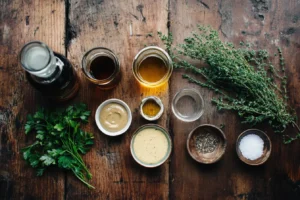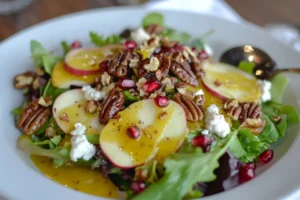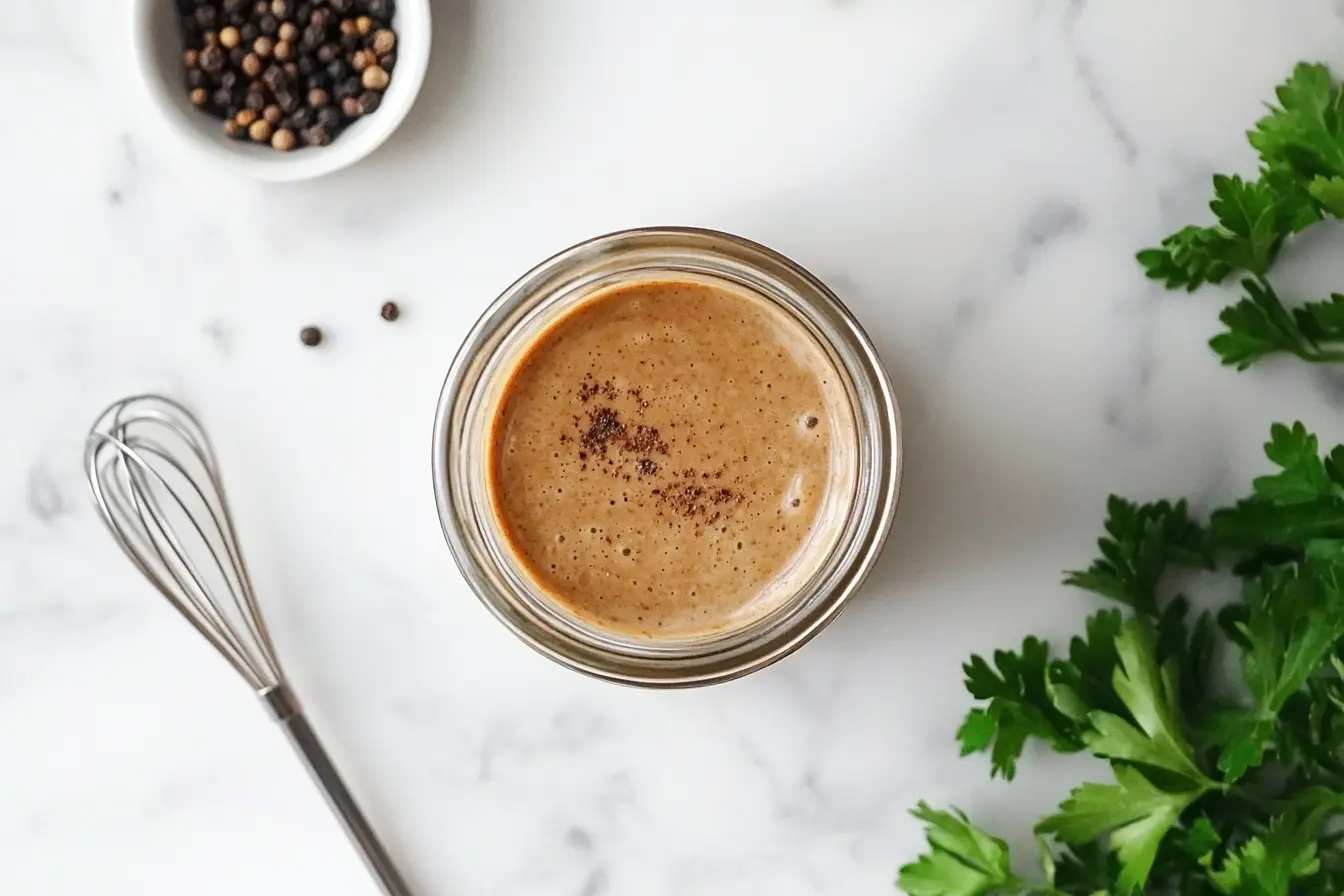If you’re looking for a dressing that’s the perfect blend of sweetness, tanginess, and versatility, you’ve landed in the right spot. Maple Dijon Dressing has quickly become a beloved staple in kitchens across the globe for its ability to transform simple dishes into gourmet meals. Whether you drizzle it over a fresh salad, use it as a marinade, or add a unique twist to roasted veggies, this dressing is all about elevating flavors without breaking a sweat.
In this article, we’ll explore everything about Maple Dijon Dressing—from what makes it special, how to make it, and its countless culinary applications, to the nutritional benefits it offers. By the time you finish reading, you’ll be fully equipped to prepare, customize, and use this dressing like a pro. So, grab your whisk and let’s dive in!
What Is Maple Dijon Dressing?
A Brief History of Maple Dijon Dressing
The pairing of maple syrup and Dijon mustard might sound like an unlikely duo, but their flavors are truly a match made in heaven. Dijon mustard’s French origins date back to the 1850s when it gained fame for its smooth, tangy flavor, while maple syrup, deeply rooted in North American traditions, has been a go-to sweetener for centuries. The fusion of these two ingredients, both cherished for their unique tastes, has given rise to a dressing that feels both luxurious and comforting.
Why Maple Dijon Dressing Is a Must-Try
What makes Maple Dijon Dressing so irresistible? It’s the flavor trifecta: the sweetness of the maple syrup, the bold tang of Dijon mustard, and the richness of olive oil that ties everything together. This dressing isn’t just tasty—it’s incredibly versatile. Use it as a salad dressing, marinade, glaze, or even as a dipping sauce. Whether you’re hosting a dinner party or prepping a quick lunch, this condiment is your secret weapon for making dishes shine.
Key Ingredients in Maple Dijon Dressing
Maple Syrup: The Sweet Star
 Maple syrup does more than just add sweetness to the dressing; it brings depth and a hint of earthiness. Always go for pure maple syrup (not the artificial kind), as it not only enhances flavor but also provides natural vitamins and minerals. Fun fact: Did you know that maple syrup contains antioxidants and may have anti-inflammatory benefits?
Maple syrup does more than just add sweetness to the dressing; it brings depth and a hint of earthiness. Always go for pure maple syrup (not the artificial kind), as it not only enhances flavor but also provides natural vitamins and minerals. Fun fact: Did you know that maple syrup contains antioxidants and may have anti-inflammatory benefits?
Dijon Mustard: The Tangy Element
Dijon mustard brings the signature sharpness to the dressing, balancing the sweetness of the maple syrup. Authentic Dijon mustard, especially one sourced from France, has a creamier texture and more refined flavor. It’s what gives this dressing its sophisticated tang.
Other Essential Ingredients
- Olive Oil: This forms the base of the dressing, adding richness and silkiness to the texture.
- Vinegar: Apple cider vinegar is a popular choice for its mild tang and subtle fruity undertones, but feel free to experiment with other vinegars like rice vinegar for a slightly different flavor.
- Seasonings: Salt, pepper, and even a pinch of garlic powder can take the dressing to the next level. Want to get creative? Try adding fresh herbs like thyme or parsley for an herby twist.
Pro Tip: Always taste as you go! The beauty of homemade dressings lies in their adjustability—add more maple syrup if you prefer it sweeter or extra Dijon mustard for an extra punch of tang.
How to Make Maple Dijon Dressing at Home
Simple Recipe for Maple Dijon Dressing
Ingredients You’ll Need
Creating Maple Dijon Dressing at home is as easy as pie, and the best part is that you likely already have most of the ingredients in your pantry! Here’s what you’ll need:
- 3 tablespoons pure maple syrup (preferably Grade A for its light, sweet flavor)
- 2 tablespoons Dijon mustard (smooth and creamy for that authentic taste)
- ¼ cup olive oil (extra virgin is best for its rich flavor and health benefits)
- 1 tablespoon apple cider vinegar (or substitute with lemon juice for a zesty kick)
- A pinch of salt and freshly cracked black pepper
- Optional add-ons: A clove of minced garlic, a teaspoon of fresh thyme, or a sprinkle of chili flakes for some heat
Step-by-Step Instructions
Making Maple Dijon Dressing is incredibly simple, and the entire process takes less than five minutes. Follow these steps to achieve a perfectly emulsified dressing:
- Combine the Ingredients: In a small mixing bowl, add the maple syrup, Dijon mustard, apple cider vinegar, salt, and pepper. If you’re using garlic or herbs, toss them in at this stage.
- Whisk It All Together: Slowly drizzle in the olive oil while whisking vigorously. This helps the dressing emulsify, creating a silky-smooth texture.
- Taste and Adjust: Dip a spoon into the dressing and taste. If it’s too tangy, add a bit more maple syrup. If it’s too sweet, a splash of vinegar will balance it out.
- Store Properly: Pour the dressing into a clean mason jar or any airtight container. Store it in the refrigerator for up to a week, and shake it well before each use.
Variations and Customizations
One of the best things about homemade Maple Dijon Dressing is how customizable it is. Here are some creative twists to suit your taste preferences:
- Vegan Option: Use agave syrup instead of honey or maple syrup.
- Sugar-Free Version: Opt for monk fruit sweetener or stevia drops to cut down on sugar.
- Add Citrus: Squeeze in fresh orange juice for a citrusy undertone that pairs beautifully with salads.
- Creamy Version: Add 1-2 tablespoons of Greek yogurt or mayonnaise to turn this into a creamy dressing perfect for slaws.
Culinary Uses for Maple Dijon Dressing
Maple Dijon Dressing as a Salad Dressing
There’s no denying that Maple Dijon Dressing shines brightest when paired with salads. Its balance of sweet and tangy flavors complements leafy greens and hearty toppings alike. Whether you’re preparing a simple side salad or crafting an impressive main-course dish, this dressing has the versatility to elevate every bite.
Best Salads for This Dressing
While Maple Dijon Dressing can be used on virtually any salad, some combinations stand out more than others. A spinach and goat cheese salad is a fantastic pairing. The creaminess of goat cheese works beautifully with the dressing’s smooth sweetness, while toasted pecans or walnuts add a satisfying crunch. Similarly, a grilled chicken and arugula salad benefits from the dressing’s sharpness, which cuts through the richness of the chicken and balances the peppery notes of arugula.
Want more ideas? Mixed greens with sliced apples, dried cranberries, and crumbled feta cheese are also a delight when drizzled with this dressing. You can even toss in roasted sweet potatoes for a hearty autumn-inspired dish.
Pairing Suggestions for Leafy Greens
Different types of greens bring out unique qualities in the dressing. For instance, Maple Dijon Dressing enhances the subtle sweetness of butter lettuce but also tempers the bitterness of kale or radicchio. If you’re making a salad with spinach, don’t forget to add a handful of fruits, like blueberries or pomegranate seeds, to amplify the flavor profile.
Beyond Salads: Other Uses for Maple Dijon Dressing
While it’s undeniably a star on salads, this versatile dressing isn’t limited to greens—it can do so much more.
Marinades for Proteins
Did you know that Maple Dijon Dressing doubles as a fantastic marinade? Its natural sugars caramelize beautifully when cooked, making it ideal for chicken, pork, or even tofu. Simply coat your protein in the dressing and let it sit for 30 minutes to an hour before cooking. The result? A flavorful, slightly sticky glaze that takes your dish to the next level.
Glaze for Roasted Vegetables
Roasted veggies, such as carrots, brussels sprouts, or butternut squash, become absolutely irresistible with a drizzle of this dressing. Before roasting, toss your vegetables in a mix of Maple Dijon Dressing and olive oil. The sugars from the maple syrup will caramelize in the oven, creating a glossy, golden finish with a hint of tang.
Dipping Sauce for Appetizers
You’ll also find that this dressing makes a delectable dipping sauce for snacks and appetizers. From fresh veggie platters to chicken skewers, it adds a burst of flavor without overwhelming the dish. For a fun twist, mix it with a spoonful of Greek yogurt or sour cream to create a creamy dip for sweet potato fries or crispy zucchini sticks.
If you’re feeling adventurous, use Maple Dijon Dressing as a sauce for grain bowls or drizzle it over quinoa with roasted chickpeas and avocado slices. The options are truly endless!
Health Benefits and Nutritional Profile
Nutritional Information of Maple Dijon Dressing
If you’re wondering whether Maple Dijon Dressing can fit into your diet, the answer is a resounding yes! Not only is it flavorful, but it’s also made with wholesome ingredients that offer several nutritional benefits. While it’s true that the calorie count will depend on the exact proportions of ingredients you use, a typical serving (about 2 tablespoons) contains roughly 120–150 calories. This comes primarily from the healthy fats in olive oil and the natural sugars in maple syrup.
Calories and Macros
A serving of Maple Dijon Dressing typically includes:
- Calories: 120–150 (varies based on the ratio of olive oil and maple syrup)
- Fats: 10–12 grams (mostly from heart-healthy monounsaturated fats in olive oil)
- Carbohydrates: 5–8 grams (primarily natural sugars from maple syrup)
- Protein: Less than 1 gram
Because the dressing is relatively low in carbohydrates, it can be a great addition to balanced meals, especially if you’re mindful of portion sizes.
Vitamins and Minerals
Thanks to the maple syrup and Dijon mustard, this dressing also delivers small amounts of essential vitamins and minerals. For example, maple syrup contains trace amounts of calcium, potassium, and zinc, while Dijon mustard may provide a slight boost of selenium. Although the amounts are minimal, every little bit adds up when you’re incorporating natural ingredients into your meals!
Health Considerations and Dietary Modifications
While Maple Dijon Dressing can be part of a healthy diet, there are a few considerations to keep in mind. But don’t worry, we’ll walk you through easy adjustments to suit various dietary needs!
Low-Carb or Keto Adaptations
If you’re following a low-carb or ketogenic diet, you might be concerned about the sugar in maple syrup. The good news is, you can swap the maple syrup for a low-carb alternative like monk fruit sweetener or a keto-friendly maple syrup substitute. This way, you can still enjoy the sweet-tangy flavor without breaking your dietary goals.
Gluten-Free Considerations
The basic recipe for Maple Dijon Dressing is naturally gluten-free, which is fantastic news for those with gluten sensitivities or celiac disease. However, you should always double-check your Dijon mustard and vinegar to ensure they don’t contain hidden gluten. Most brands are safe, but it’s always better to read labels.
Reduced-Sodium Tips
Although Dijon mustard is flavorful on its own, it can sometimes contain a higher sodium content. If you’re watching your sodium intake, opt for a low-sodium Dijon mustard or make your own mustard from scratch! Additionally, reducing the added salt in the recipe can help you control the overall sodium content.
Pro Tip: For an extra nutritional boost, consider mixing in finely chopped superfoods like kale, parsley, or chia seeds. Not only will these add texture, but they’ll also enhance the health benefits of the dressing.
Final Thoughts on Nutrition
While Maple Dijon Dressing can be indulgent, it’s also a healthier alternative to many store-bought dressings, which are often loaded with preservatives, artificial sweeteners, and unhealthy fats. By making it at home, you can take control of the ingredients and customize it to suit your lifestyle. Plus, knowing you’ve crafted something so delicious from scratch makes it taste even better!
Maple Dijon Dressing in Different Cuisines
How Maple Dijon Dressing Fits into Global Flavors
 You might think of Maple Dijon Dressing as a purely North American creation, but its flavors are surprisingly versatile and adaptable to a wide range of cuisines. Thanks to the bold tang of Dijon mustard and the natural sweetness of maple syrup, this dressing complements not only traditional dishes but also those with European and Mediterranean influences. It’s amazing how one simple dressing can unite such diverse culinary traditions!
You might think of Maple Dijon Dressing as a purely North American creation, but its flavors are surprisingly versatile and adaptable to a wide range of cuisines. Thanks to the bold tang of Dijon mustard and the natural sweetness of maple syrup, this dressing complements not only traditional dishes but also those with European and Mediterranean influences. It’s amazing how one simple dressing can unite such diverse culinary traditions!
North American Dishes
In North America, Maple Dijon Dressing is often associated with hearty, comforting meals. For example, it’s a natural fit for grain bowls that feature quinoa, roasted sweet potatoes, and kale. The dressing ties all the components together with its unique combination of flavors. Furthermore, it’s a popular glaze for roasted veggies—especially carrots and parsnips, which caramelize beautifully under the heat of the oven when coated with the dressing.
European and Mediterranean Influence
Given that Dijon mustard originates from France, it’s no surprise that Maple Dijon Dressing fits seamlessly into European cuisine. Use it as a vinaigrette for a French-inspired salad with butter lettuce, goat cheese, and toasted hazelnuts. Or, pair it with roasted Mediterranean vegetables like zucchini, eggplant, and bell peppers for a burst of flavor that feels fresh yet familiar. Additionally, its tangy sweetness balances perfectly with grilled fish, making it an excellent choice for lighter, coastal-inspired meals.
Seasonal and Festive Recipes Using Maple Dijon Dressing
Holiday Dishes Featuring This Dressing
When the holiday season rolls around, you’ll want to have a jar of Maple Dijon Dressing ready to go. It’s perfect for dressing a holiday salad packed with festive ingredients like pomegranate seeds, dried cranberries, and candied pecans. Alternatively, use it as a glaze for roasted Brussels sprouts or carrots—it’ll impress your guests with its rich flavor and glossy finish.
For a Thanksgiving or Christmas meal, drizzle this dressing over a platter of roasted root vegetables for a side dish that feels both rustic and elegant. It also works wonders as a basting sauce for roasted poultry, enhancing its natural flavors without overpowering them.
Summer Barbecues and Fall Harvest Recipes
But let’s not forget, Maple Dijon Dressing isn’t just for the colder months. During summer, its light yet flavorful profile makes it ideal for outdoor gatherings and barbecues. Toss it with a salad of mixed greens, grilled peaches, and burrata for a dish that screams summer on a plate. You can even brush it onto skewers of chicken or veggies before grilling to achieve a subtle caramelized glaze.
In the fall, its warm, sweet tones match perfectly with the season’s produce, such as squash, apples, and cranberries. Whether you’re hosting a fall harvest dinner or simply preparing a cozy weeknight meal, this dressing ties together the earthy flavors of autumn like no other.
A Dressing for All Seasons
One of the best aspects of Maple Dijon Dressing is how easily it adapts to seasonal ingredients and celebrations. Whether you’re hosting a formal dinner party, preparing a casual summer picnic, or making a weekday meal for your family, this dressing will always add a layer of sophistication and depth to your dishes. And honestly, isn’t that exactly what we’re all looking for in a homemade dressing?
Tips for Buying and Storing Ingredients
Selecting the Best Ingredients
If you’ve ever wondered why homemade Maple Dijon Dressing tastes so much better than store-bought, the secret lies in the quality of the ingredients. Choosing the freshest, most authentic components makes a world of difference, and fortunately, it doesn’t have to be complicated. Let’s dive into what to look for when shopping for the key elements of this delicious dressing.
Choosing Quality Maple Syrup
When it comes to maple syrup, always opt for the real deal—pure maple syrup. While artificial syrups might be tempting due to their lower price, they lack the depth, richness, and health benefits of the authentic version. Look for syrups labeled “100% pure” and pay attention to the grade.
- Grade A syrup, with its light and delicate flavor, is perfect for dressings as it doesn’t overpower the other ingredients.
- Avoid syrups with added sugars, preservatives, or artificial flavors. Remember, the fewer the ingredients listed on the bottle, the better.
Did you know that maple syrup also contains antioxidants and small amounts of minerals like manganese and zinc? This makes it a natural and slightly healthier choice when compared to refined sugars.
Finding Authentic Dijon Mustard
When it comes to Dijon mustard, authenticity is key. While there are countless options available, not all of them deliver the same quality or flavor. For the best results:
- Choose Dijon mustard that’s imported from France, as it typically has a smoother texture and more balanced tang.
- Check the ingredient list to ensure it’s free from unnecessary additives. Ideally, it should only contain mustard seeds, vinegar, and spices.
- If possible, purchase from trusted brands like Maille or Grey Poupon, both of which are known for their high-quality mustards.
Other Ingredient Tips
Don’t forget about the supporting ingredients! A high-quality extra virgin olive oil enhances the richness of the dressing, while fresh herbs like parsley or thyme add a burst of flavor. When selecting vinegar, apple cider vinegar is a great choice because of its mild acidity, but you can experiment with white balsamic or rice vinegar for a slightly different twist.
Storage Tips for Maple Dijon Dressing
Making a batch of Maple Dijon Dressing is simple, but storing it properly ensures you can enjoy it at its best for days to come. While it doesn’t contain any artificial preservatives, a few tips will help prolong its freshness and flavor.
Refrigeration Guidelines
Once you’ve whisked together your dressing, transfer it into a clean, airtight container—such as a mason jar or a glass bottle with a lid. Store it in the refrigerator to keep it fresh and safe to consume. Properly refrigerated, the dressing can last for up to 7–10 days.
However, because olive oil tends to solidify when chilled, you might notice that the dressing thickens in the fridge. Don’t worry—it’s completely normal! Simply take the jar out 10–15 minutes before using it and give it a good shake or whisk to bring it back to its smooth, pourable consistency.
Maintaining Freshness
- Always use clean utensils when scooping or pouring the dressing to avoid introducing bacteria.
- If you’ve added fresh garlic or herbs to your dressing, it might have a shorter shelf life (closer to 5 days), so plan to use it more quickly.
- For optimal flavor, let the dressing sit at room temperature for a few minutes before serving to allow the ingredients to “wake up.”
Prolonging Shelf Life
Although Maple Dijon Dressing is best enjoyed fresh, you can freeze it if you need to extend its life. Pour it into an ice cube tray and freeze individual portions. When you’re ready to use it, simply thaw the cubes in the fridge overnight or melt them at room temperature. Keep in mind that freezing may slightly alter the dressing’s texture, so it’s best reserved for emergency use.
By following these tips, you’ll not only maintain the dressing’s flavor but also avoid unnecessary waste. A little effort goes a long way in ensuring every drizzle of your Maple Dijon Dressing is as delightful as the first!
FAQs and Common Questions About Maple Dijon Dressing
How long does homemade Maple Dijon Dressing last?
Homemade Maple Dijon Dressing typically lasts between 7 to 10 days when stored properly in the refrigerator. It’s essential to keep the dressing in an airtight container, like a mason jar, to maintain its freshness. If you’ve added fresh garlic or herbs, you might want to use it within 5 days, as these ingredients can shorten its shelf life. Always give it a quick sniff or taste before using to ensure it’s still good!
Can I substitute honey for maple syrup?
Absolutely! Honey is a fantastic substitute if you don’t have maple syrup on hand or prefer its flavor. However, keep in mind that honey is slightly sweeter and thicker than maple syrup, so you might need to adjust the quantity or thin it out with a touch of water. The flavor will shift slightly, but it will still have that delightful sweet-tangy balance.
What’s the best oil to use in Maple Dijon Dressing?
Olive oil is the most popular choice because of its smooth, rich flavor and health benefits. However, you can experiment with other oils depending on your taste preferences. Avocado oil works well for a milder flavor, while walnut oil adds a nutty undertone. Avoid using neutral oils like canola or vegetable oil, as they lack the depth that makes the dressing shine.
Is Maple Dijon Dressing safe for kids?
Yes, Maple Dijon Dressing is safe for children to enjoy! Its natural sweetness from maple syrup often appeals to kids, making it a great way to encourage them to eat more salads or veggies. Just be cautious if you’re serving it to very young children, as they might have sensitivities to mustard’s tangy kick.
What’s the difference between Dijon mustard and yellow mustard?
Dijon mustard is smoother, creamier, and has a tangier, more complex flavor compared to yellow mustard. Yellow mustard, on the other hand, is milder and often slightly sweeter. Dijon’s refined flavor makes it the better choice for Maple Dijon Dressing, as it pairs beautifully with the sweetness of maple syrup and the richness of olive oil.
Can I freeze Maple Dijon Dressing?
Yes, you can freeze Maple Dijon Dressing, although it’s best enjoyed fresh. To freeze it, pour the dressing into an ice cube tray and freeze individual portions. Once frozen, transfer the cubes into a freezer-safe bag or container. To use, simply thaw a cube in the refrigerator or at room temperature. Keep in mind that freezing might slightly affect the texture, so give it a good whisk before serving.

